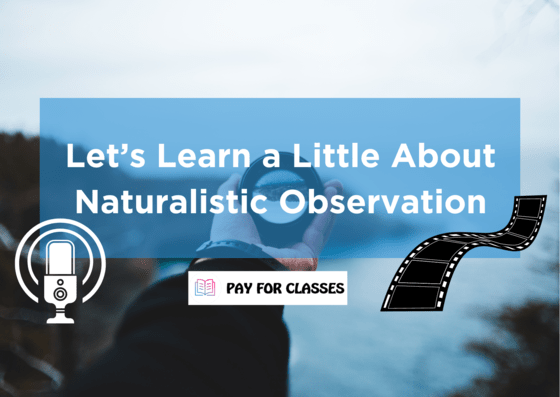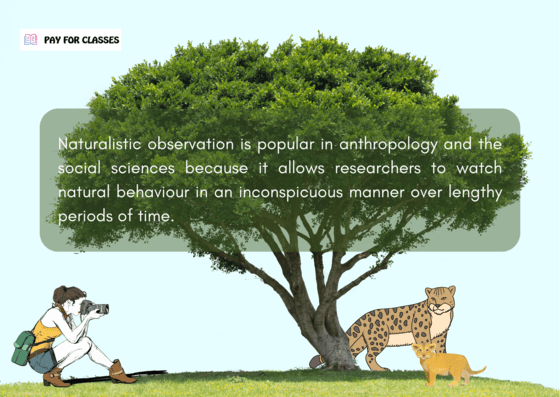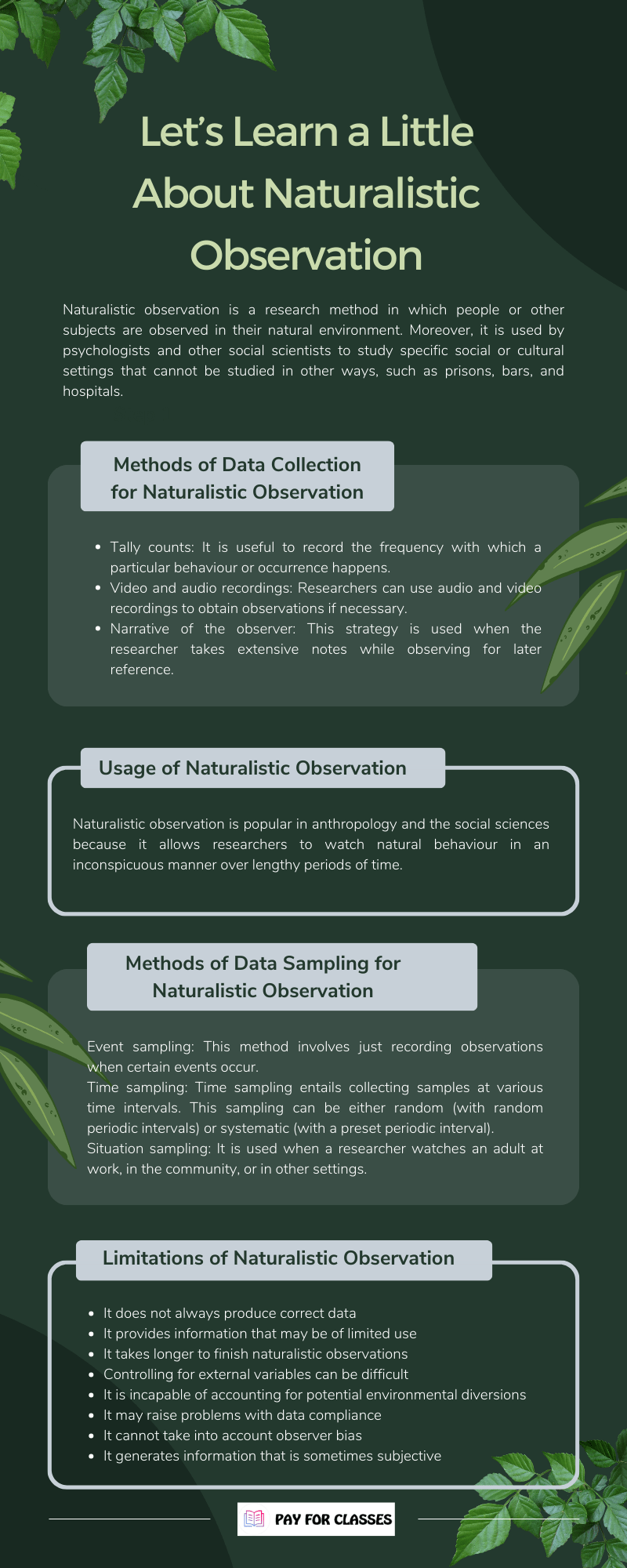
If you are a keen learner of research methodology, then you must learn about naturalistic observation. This is a research method that you can use as a student of psychology and other social sciences. Moreover, with the help of this method, you can learn about your research participant in their natural surroundings. Here, you would not require any testing equipment or controlling variables. However, just recording would serve a huge purpose.
In this blog, composed by the expert writers at Pay for Classes, we will learn more about naturalistic observation, its data collection and data sampling methods, its usage and limitations. In addition to this, you can let our experts know if you need any online class help in any of your subject disciplines. As an academic support website, we are always here to assist you regardless of time, location, or situation.
Introduction to Naturalistic Observation
Naturalistic observation is a research method in which people or other subjects are observed in their natural environment. Moreover, it is used by psychologists and other social scientists to study specific social or cultural settings that cannot be studied in other ways, such as prisons, bars, and hospitals. Furthermore, one disadvantage of naturalistic observation is the inability to control for factors and the lack of replicability. Also, the two primary categories of naturalistic observations are as follows.
- Covert or overt: In this situation, researchers may choose to conceal or reveal their identity as an observer to those being observed.
- Participant or spectator: You can either join the exercise or watch from the stands.
Methods of Data Collection for Naturalistic Observation
You can collect data for naturalistic observation using a variety of approaches. Among these are:
Tally counts
When a researcher records a tally every time an event occurs, this is known as tally count sampling. It is useful to record the frequency with which a particular behaviour or occurrence happens.
Video and audio recordings
Researchers can use audio and video recordings to obtain observations if necessary. Moreover, these recordings can be returned later, compared to previous observations, and shared with other trained observers to identify changes or measure progress. However, while using this strategy, researchers must ensure that they have obtained written permission from all participants before commencing to record. Also, to avoid distracting the participants, recording equipment should be placed discretely.
Narrative of the observer
This strategy is used when the researcher takes extensive notes while observing for later reference. Moreover, everything important or related to the research topic is written down in an unstructured manner. Furthermore, these notes might be used to construct a research article or to outline specific behaviours observed by the researcher.
As mentioned above, you can contact us anytime for academic assistance. The research process is undoubtedly a time-taking activity and chances are, you might face difficulty in your academic subjects. For example, if you are conducting research on naturalism in the philosophy of Mathematics and missing some of your crucial algebra topics, then you can seek algebra online class help from us. Now, let us move forward towards the usage of naturalistic observation.
Usage of Naturalistic Observation
Naturalistic observation is popular in anthropology and the social sciences because it allows researchers to watch natural behaviour in an inconspicuous manner over lengthy periods of time. Because timescales in research are significantly shorter and we often need to examine complex activities up close, we use contextual inquiry more frequently, which is a very cost-effective approach to learning about people’s tasks. Participants can walk you through their essential activities in as little as an hour or two.

Contextual enquiries, on the other hand, are partially fabricated. You plan a two-hour time frame and invite participants to show you their responsibilities, regardless of whether they regularly accomplish those chores at that time. As a result, they may have to reproduce or imitate specific circumstances in order to demonstrate what they regularly accomplish. Eventually, you will not be able to understand how those chores fit into their weekday in a realistic manner. You may not see examples of various variations, exceptions, issues, and interruptions that are common in their day-to-day tasks. While you can see what participants do when performing a job on their own, you are less likely to notice the interactions between numerous people that occur on a daily basis.
This is where, a naturalistic observation allows you to watch what happens over time, whether you are monitoring one individual or a group of people. You can observe how a typical day unfolds without interfering or influencing the individuals. For example, while you may learn about specific problems during a contextual inquiry, observing participants over a longer period of time provides a greater insight into how frequently such problems arise and what causes them.
Using naturalistic observation with other methods
Naturalistic observation is best used in conjunction with other activities such as contextual enquiries and interviews. However, because you cannot see things up close or ask questions, you should not rely just on naturalistic observation.
Instead, spend a day or two doing contextual inquiries with several participants, followed by a day or two simply observing the group. Moreover, contextual enquiries will provide you with a good grasp of the participants, their tasks, and the problems and issues to look out for throughout the naturalistic observation. Furthermore, you could conduct extra interviews at the end of the last day to gain answers to your questions and validate your grasp of what you have observed. Combining various strategies gives you the benefits of each while minimizing their drawbacks.
Also read: How Interactive Learning in Online Science Classes Helps Students Gain Better Subject Understanding
Methods of Data Sampling for Naturalistic Observation
It is rarely viable or possible to collect data from every moment of a subject’s life. To acquire information, researchers typically use data sampling. Moreover, the goal of sampling is to guarantee that the data acquired is reflective of the participant’s general behaviour. Furthermore, a representative sample can be obtained by a researcher using a variety of ways, including:
Event sampling
This method involves just recording observations when certain events occur. Moreover, a tally count can be used to record the frequency of occurrence. Furthermore, event sampling allows researchers to better identify any trends that may exist.
Time sampling
Time sampling entails collecting samples at various time intervals. This sampling can be either random (with random periodic intervals) or systematic (with a preset periodic interval). Moreover, interesting behaviours that occur during these times are documented. Time sampling assists researchers in identifying regular routines followed by participants, which can aid in the development of a study on common patterns.
Situation sampling
Researchers use context sampling to monitor participants’ behaviour in a variety of circumstances and locations. However, situation sampling is used when a researcher watches an adult at work, in the community, or in other settings. This strategy can assist in assessing whether particular behaviours occur only in certain contexts.
In addition to this, contact us for calculus online class help whenever you find it complex to combat with your research process and other subject classes.

Limitations of Naturalistic Observation
Given below are some major limitations of naturalistic observation.
It does not always produce correct data
Even if they are in a natural situation, people will react differently if they know they are being watched. When dealing with personal decisions, ethics, and morality, humans are sensitive to the accountability element. Also, when people are aware that their actions are being recorded, they will try to act in the most “correct” way possible. For social scientists, this indicates that the people involved may endeavour to appear acceptable or desirable from a social standpoint. Furthermore, even when researchers take steps to prevent this disadvantage, it can be difficult to completely eradicate the problem.
It provides information that may be of limited use
The data collected by social scientists through naturalistic observation is frequently beneficial during the early phases of a study program. Moreover, it can assist researchers in laying the groundwork for an opinion or it can create an opportunity that leads to validated results. Furthermore, once the project progresses beyond this first stage, the value of the data becomes “hit or miss” in terms of value. As a result, a project may begin with this strategy and then transition to something else in the future.
It takes longer to finish naturalistic observations
When compared to the other options available to social scientists, this study method necessitates a greater time commitment. Moreover, specific choices or behaviours take longer to surface, especially when someone is aware that they are being observed. Even with all of the benefits of a natural reaction while collecting data, the amount of time required to produce findings can be significant. Some projects take several years before they have enough knowledge to conclude the research phase.
Controlling for external variables can be difficult
The inclusion of outside variables can make it difficult for researchers to pinpoint the specific cause of behaviours or choices. When working in a natural setting, there are several factors that might cause people to behave in unexpected ways. Moreover, someone who had an altercation at home before going to class may react differently in terms of socialization than someone who received good news.
As far as the external variables are concerned, we are here to ensure that any external variable cannot prevent you from taking your online classes when we are withstanding against all odds. For example, if the research process is coming your way to your biology class, then you can contact our experts for biology online class help. We are available for assistance 24/7.
It is incapable of accounting for potential environmental diversions
During a naturalistic observation attempt, researchers can control some variables, but not all. Distractions have the potential to alter the way people connect with one another. For example, consider a classroom where social scientists are observing how students learn. If a loud horn blared repeatedly outside of that controlled atmosphere, the interactions of the persons involved would change. Instead of focusing on the teacher, their attention would be drawn to the ruckus outside. Any information gathered during this time frame would be essentially worthless.
It may raise problems with data compliance
Some people will also try to behave or present options that they believe will conform to what they expect for the goal of the research study. Moreover, there may be tiny indications in the environment that some participants notice, consciously or unconsciously, that express to them what the scientists seek to discover with their research. When this problem arises under naturalistic observation conditions, some people may change their behaviour to “go along” with what they feel the researchers want to see from them.
It cannot take into account observer bias
Naturalistic observation yields no clear results since there is no mechanism to account for observational bias. Although this limitation applies to practically all research methods, this option collects information through direct observation of behaviour. Even unconscious bias might have an effect on the final findings without the researchers being aware of it. That means that social scientists have little or no control over a situation or the outcomes of their work.
It generates information that is sometimes subjective
When numerous witnesses of behaviour or decision are involved in a research product, each person may draw a different conclusion from the same behaviours that everyone watched. It is not rare for two researchers to see identical actions but to ascribe them to different causes.
Also read: E-Learning in Geography: A Fresh Outlook Following the Pandemic
Conclusion
Naturalistic observation can be useful in the study. Moreover, it has a lot of advantages, including being less expensive and less intrusive than other methods of study. However, in some circumstances, researchers may use naturalistic observation to learn more about something that is happening in a specific group. Using this knowledge, they can then develop a hypothesis that can be tested further.
Frequently Asked Questions
Question: 1 What is a naturalistic approach?
Answer: 1 Putting cameras in a subject’s natural surroundings, such as a bird, allows researchers to collect data without risking the creatures becoming aware of their presence and affecting their behaviour.
Question: 2 What is the naturalistic education approach?
Answer: 2 Naturalistic instructional approaches are an evidence-based practice that educators can use to teach critical skills throughout ongoing classroom activities. Literacy, writing, math, functional, social, and communication abilities can all be taught via naturalistic training.
